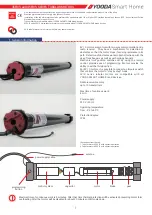
16
L510010D-17
INSTRUMENTATION
Boat manufacturers install many different types of
instrumentation on boats. Become familiar with the
instrumentation on your boat and be aware of abnormal
operating conditions. The following is a brief explanation
of typical instrumentation found on most boats:
1. Tachometer - indicates the engine RPM
(revolutions per minute)
2. Water Temperature Gauge - indicates the engine
coolant temperature
3. Oil Pressure Gauge - indicates the engine oil
pressure
4. Voltmeter - indicates the battery voltage and
charging system voltage
5. Hour Meter - indicates the engine operating time
6. Fuel Level Gauge - indicates the fuel tank level
7. Malfunction Indicator Lamp (MIL) or Check
Gauges Lamp - indicates a problem with the
engine control system
Notice:
Many boat manufacturers are using Controller
Area Network (CAN) based instrumentation. This
instrumentation is driven by a two-wire network from
the engine. Refer to your boat manufacturers Owners
manual for the type of instrumentation being used with
your application.
OPERATING INSTRUCTIONS - 5
CHECK
ENGINE
TACH
0
10
20 30
60
50
40
E
FUEL
1/2
F
TEMP
200
170
100
80
40
0
OIL
VOLT
10
16
13
Figure 5-1
Typical Instrument Panel
MALFUNCTION INDICATOR LAMP
MIL
CHECK GAUGES LAMP
CGL
Figure 5-1A
Example Warning Lamp Cluster
STARTING ENGINE (FUEL INJECTED ENGINES)
WARNING
Before starting engine, ventilate the engine
compartment by operating the bilge blower for
a minimum of five minutes to remove any gas
fumes from the engine compartment. If the boat
is not equipped with a blower, open the engine
compartment hatches to ventilate and leave open
while starting engine.
IMPORTANT: Do not start the engine without water
being supplied to the sea water pick-up pump or
sea-water pump impeller will be damaged, and
subsequent overheating damage to the engine may
result.
IMPORTANT: The following items should be
checked before starting the engine, and each time
the boat is operated:
• Fuel system for any signs of leakage
• Operation of remote controls and steering
• Engine and transmission oil levels
• Fuel tank levels
• Exhaust system for leaks and tightness of the
clamps
• Battery connections and water level in battery
cells
• Accessory drive belt(s)
• Cooling system for leaks. If equipped with fresh-
water cooling, check coolant level in recovery
bottle. Check for signs of water leaks at the
exhaust manifolds, risers and elbows (Figure
5-2). If the water is leaking externally, it is
possible that the water is also leaking internally.
This could result in internal engine damage. It
is very important to service these maintenance
items as soon as a problem is indicated. After
performing the initial safety checks, proceed as
follows to start the engine:
1. Turn the battery switch ON (if equipped).
2. Open the fuel valve.
3. Open the seacock.
4. Place the remote control in Neutral position. The
transmission is equipped with a neutral safety
switch, which will not allow the starter motor to
operate unless the transmission is in neutral.
Summary of Contents for DI Catanium CES
Page 1: ...OWNER S OPERATION AND MAINTENANCE MANUAL...
Page 2: ...This Page Was Intentionally Left Blank...
Page 12: ...8 L510010D 17 This Page Was Intentionally Left Blank INTRODUCTION 1...
Page 66: ...62 L510010D 17 NOTES 20...
Page 69: ...This Page Was Intentionally Left Blank...
Page 70: ...Pleasurecraft Engine Group 1737 Highway 76 East Little Mountain SC 29075...
















































